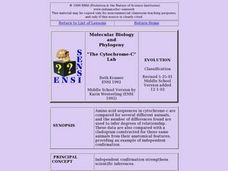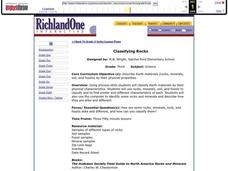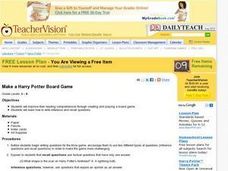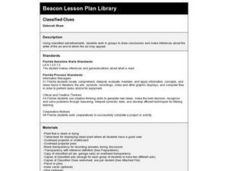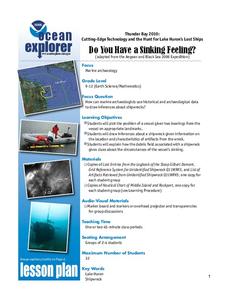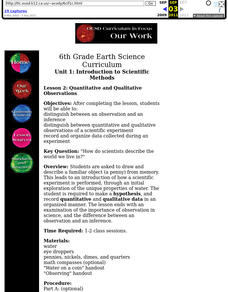Curated OER
Glaciers and Icebergs
Students conduct an experiment on glacial scraping. In this glacial scraping lesson, students create a small glacier in a plastic cup. Students remove the cup and scrape the glacier across wood and note the markings. Students then make...
Curated OER
What's the Best Deal?
Students explore number sense by solving consumer math problems. In this pattern identification activity, students analyze a list of numerical and geometric patterns while predicting the future outcome. Students utilize inference skills...
Curated OER
What Is the Nature of Science?
Students distinguish between scientific and everyday meanings of key words-theory, hypothesis, law, fact-and use in context. They recognize the variables that affect observation, data collection, and interpretation. They discover the...
Curated OER
Grand Canyon
In this Grand Canyon learning exercise, students answer 5 true or false questions that involve making inferences from a reading passage about the Grand Canyon. Then the students write a short opinion paragraph where they help the family...
Creative Chemistry
The Chemical Detective
In this chemical detectives worksheet, students perform six tests on various unknown solutions, including a test for chloride ions, sulphate ions, carbonate ions, iron (III) ions, iron (II) ions, and copper (II) ions. Students record...
Curated OER
What Made George Washington a Good Military Leader?
Learners identify the qualities of an effective military leader. For this Revolutionary War lesson, students view several Internet resources about George Washington's life. Student groups research one of four battles, and document their...
Curated OER
Cartoons for the Classroom: 9/11 Revisited
Political cartoons about the September 11 terrorist attacks provide an opportunity for class members to analyze the inferences embedded in the drawings.
Curated OER
Veggie Chop and Data Analysis
First graders chop vegetables into fractions. In this fractions lesson plan, 1st graders cut vegetables, collect data about favorite vegetables and create a bar graph using the information. Students make inferences about the data...
Curated OER
The Cytochrome-C Lab
Young scholars examine a method biologists use to try to determine relationships. They examine how amino acid sequences have been determined for a number of proteins, and how scientists can make inferences about DNA based on the amino...
Curated OER
Eating Healthy
Students review healthy eating habits, and demonstrate reading comprehension skills, including reading strategies, inference, literal meaning, and critical analysis.
Curated OER
Maniac Magee: Questions to Foster Discussion
This resource provides 11 short answer questions and a couple of extension ideas related to part one of Jerry Spinelli's novel about a feisty runaway. Not reproducible, but the questions (which address vocabulary, inference, recall,...
Curated OER
Physical Properties of Ice
Students demonstrate that ice melts faster under pressure. They recognize that ice can be broken up or melted by pressure and then refreeze.
Curated OER
Traveling With Limited Funds; A Tree Grows in Brooklyn
Students participate in a pre-reading activity which helps them see what it would be like to live in poverty. In this reading comprehension lesson, students make a list of items they take on a trip considering they have very limited...
Curated OER
Classifying Rocks
Third graders classify rocks. In this rocks and minerals lesson plan, 3rd graders observe, make inferences and conclusions about rocks, minerals, soil and fossils.
Curated OER
Make a Harry Potter Board Game
Learners, in groups, make a Harry Potter Board Game. They explore how to write inference and recall questions.
Curated OER
Classified Cues
Students analyze classified advertisements to make inferences about who wrote the ad and who may find the ad appealing. They write their own classified ads based on what they have learned.
Curated OER
Analyzing Graphs and Data
Students collect and analyze data. In this statistics lesson, students graph their data and make inferences from the collected data. They display their data using graphs, bar graphs, circles graphs and Venn diagrams.
Curated OER
Hierarchical Organization in Biology: Students Presentations of Neurobiology
Students gather (research) information on neuron structure and action potential. Students are guided to make inferences about the synapse and its relationship to neurotransmitter release and action. They are also guided to make...
Curated OER
Civil War Music - Irish Folk Songs
Students determine what it was like to serve as an Irish-American in the American Civil War. In this Irish folk song lesson, students use the provided worksheets to analyze selected Irish folk songs and make inferences about war...
Curated OER
Location, Location, Location: Using a Grid to Determine Context
Seventh graders are introduced to making inferences about artifacts. Using a grid system, they locate the artifacts and determine where they originated from. They use this information to make conclusions about the way people lived...
Curated OER
Do You Have a Sinking Feeling?
Young scholars explore how marine archaeologists use data to draw inferences about shipwrecks. In this marine archeology lesson students plot the position of a vessel, draw inferences about a shipwreck and explain the possible...
Curated OER
Dig It Up
Students participate in an archaeological excavation to determine how archeologists make inferences about various cultures. They reconstruct the site using layers of drawings. They discuss the kinds of information they learned.
Curated OER
Introduction to Scientific Methods
Sixth graders distinguish between an observation and an inference distinguish between quantitative and qualitative observations of a scientific experiment. They record and organize data collected during an experiment.
Curated OER
The Aging Population of Canada
High schoolers analyze age-group population data and make inferences on the impact of the aging population in Canada. They, in groups, focus on health care, social programs and labor issues.








